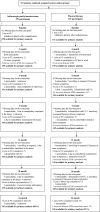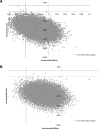How do the costs of physical therapy and arthroscopic partial meniscectomy compare? A trial-based economic evaluation of two treatments in patients with meniscal tears alongside the ESCAPE study
- PMID: 31227493
- PMCID: PMC7212930
- DOI: 10.1136/bjsports-2018-100065
How do the costs of physical therapy and arthroscopic partial meniscectomy compare? A trial-based economic evaluation of two treatments in patients with meniscal tears alongside the ESCAPE study
Abstract
Objectives: To examine whether physical therapy (PT) is cost-effective compared with arthroscopic partial meniscectomy (APM) in patients with a non-obstructive meniscal tear, we performed a full trial-based economic evaluation from a societal perspective. In a secondary analysis-this paper-we examined whether PT is non-inferior to APM.
Methods: We recruited patients aged 45-70 years with a non-obstructive meniscal tear in nine Dutch hospitals. Resource use was measured using web-based questionnaires. Measures of effectiveness included knee function using the International Knee Documentation Committee (IKDC) and quality-adjusted life-years (QALYs). Follow-up was 24 months. Uncertainty was assessed using bootstrapping techniques. The non-inferiority margins for societal costs, the IKDC and QALYs, were €670, 8 points and 0.057 points, respectively.
Results: We randomly assigned 321 patients to PT (n=162) or APM (n=159). PT was associated with significantly lower costs after 24 months compared with APM (-€1803; 95% CI -€3008 to -€838). The probability of PT being cost-effective compared with APM was 1.00 at a willingness to pay of €0/unit of effect for the IKDC (knee function) and QALYs (quality of life) and decreased with increasing values of willingness to pay. The probability that PT is non-inferior to APM was 0.97 for all non-inferiority margins for the IKDC and 0.89 for QALYs.
Conclusions: The probability of PT being cost-effective compared with APM was relatively high at reasonable values of willingness to pay for the IKDC and QALYs. Also, PT had a relatively high probability of being non-inferior to APM for both outcomes. This warrants further deimplementation of APM in patients with non-obstructive meniscal tears.
Trial registration numbers: NCT01850719 and NTR3908.
Keywords: arthroscopic partial meniscectomy; economic evaluation; knee; physical therapy; randomised controlled trial.
© Author(s) (or their employer(s)) 2020. Re-use permitted under CC BY-NC. No commercial re-use. See rights and permissions. Published by BMJ.
Conflict of interest statement
Competing interests: All authors have completed the Unified Competing Interest form (available on request from the corresponding author) and declare: all authors had financial support from The Netherlands Organisation for Health Research and Development (in Dutch: ZonMw) for the submitted work; the Achmea Healthcare Foundation (in Dutch Stichting Achmea Gezonheidszorg fonds) and the foundation of medical research at the OLVG, Amsterdam, the Netherlands; no financial relationships with any organisations that might have an interest in the submitted work in the previous three years; no other relationships or activities that could appear to have influenced the submitted work.
Figures


References
-
- Rongen JJ, Govers TM, Buma P, et al. . Arthroscopic meniscectomy for degenerative meniscal tears reduces knee pain but is not cost-effective in a routine health care setting: a multi-center longitudinal observational study using data from the osteoarthritis initiative. Osteoarthritis Cartilage 2017. - PubMed
Publication types
MeSH terms
Associated data
LinkOut - more resources
Full Text Sources
Medical
